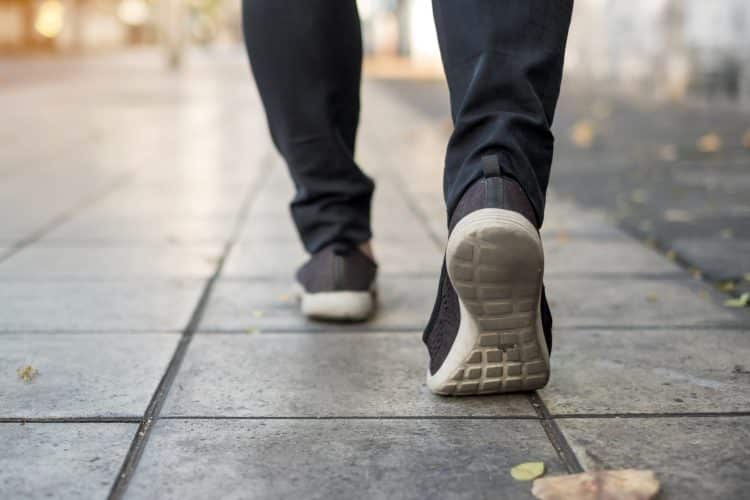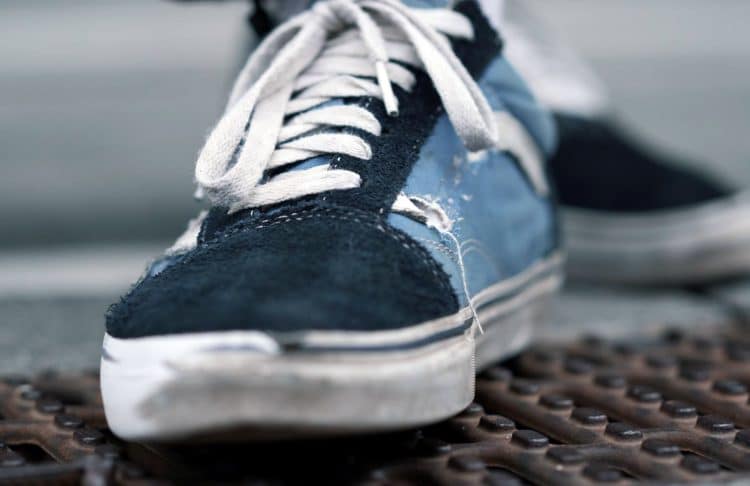I’ve been an athlete and personal trainer for more than three decades. As such, I’ve spent a lot of time performing and prescribing intense workouts. After all, if you want to get fitter, stronger, or more muscular, you need to get out of your comfort zone. Hard work drives your gains.
However, in addition to strength training and cardio, I also do a lot of walking. I don’t really count walking as exercise; it’s just part of my day.
Walking is an easy and efficient way to get from A to B, and I’m also a regular weekend hiker. Plus, as the owner of several energetic dogs, I do it to keep my furry friends happy and healthy.
But what happens when you start taking walking a little more seriously? For example, if you do 10,000 steps a day. Not for a week or a month, but an entire year?
In this article, I share the effects, benefits, and things I learned from walking 10,000 steps for 12 months straight.
The Effects and Benefits of Walking 10,000 Steps for A Year
I’ve read a lot about daily walking and its proposed health and fitness benefits. However, most articles focus on very short periods, such as seven or 30 days. While these articles make for interesting reading, they are of minimal value because seven or even 30 days is not long enough to produce many positive effects.
Level Up Your Fitness: Join our 💪 strong community in Fitness Volt Newsletter. Get daily inspiration, expert-backed workouts, nutrition tips, the latest in strength sports, and the support you need to reach your goals. Subscribe for free!
With that in mind, I thought it prudent to detail the effects and benefits of walking 10,000 steps for an entire year. Please note that these are my personal experiences, and you may not respond the same way.
Effortless Weight Loss
Walking is a very low-intensity activity. As such, it’s easy to forget that it burns more calories than sitting. While precise values vary, the average person can burn an extra 300-400 calories a day by walking 10,000 steps. Factors that affect the actual number of calories include your weight, age, speed, and terrain.
While 300-400 calories a day might sound insignificant, those calories add up over a year. Consequently, I lost several pounds and a decent amount of body fat without making any other changes to my diet or workouts.
How much weight you can lose by walking 10,000 steps is impossible to predict. However, working on the premise that a pound of fat equals 3,500 calories, and you burn 350 extra calories each day by walking, you could lose 36 or more pounds in 12 months. Of course, your results are also dependent on your diet and general lifestyle.
Regardless, studies suggest that walking 10,000 steps per day can be a valuable weight loss aid (1).
Related: Calories Burned By Walking Calculator
Decreased Resting Heart Rate
As a long-time athlete and fitness enthusiast, cardio has always been part of my training regimen. Consequently, my resting heart rate (RHR) has always been relatively low. For many years, it’s hovered around 55-60 beats per minute (BPM). This is significantly lower than the average reading, which is 72 BPM.
That said, after one year of walking 10,000 steps a day, my RHR now hovers between 45-50 bpm. A lower resting heart rate indicates that my heart can pump more blood per beat, suggesting that it’s bigger and stronger than it was before. A low resting heart rate is commonly associated with good fitness and cardiovascular health (2).
Lower Blood Pressure
High blood pressure (hypertension) has no obvious symptoms. Still, it is a risk factor for many illnesses, including heart and kidney disease. Blood pressure (BP) tends to increase with age as blood vessels start to lose their elasticity. Because of this, your blood pressure is an important health metric.
Walking 10,000 steps per day for a year caused a slight drop in my diastolic and systolic blood pressure readings. This result is not unique to me, and numerous studies support this benefit (3).
While my BP has never been high, a decrease at the time when blood pressure typically increases is nothing but good news.
Faster Recovery from Lower Body Workouts
Despite being in my 50s, I still enjoy intense workouts. While my training changes according to my current needs and goals, at least one weekly session usually results in delayed onset muscle soreness or DOMS for short.
I don’t actively chase DOMS. Instead, it’s just a side-effect of working hard. I’m especially prone to lower body soreness.
Walking 10,000 steps a day seems to alleviate DOMS and helps me recover faster between workouts. This is probably due to increased blood flow, resulting in the removal of metabolic waste products from my hard-worked muscles.
Whatever the cause, I really appreciate suffering from shorter and less severe bouts of DOMS.

Better Cardiovascular Fitness
While it’s hard to believe that something as easy as walking can improve your fitness, I’m happy to report that it does. That’s because brisk walking raises your heart and breathing rate, and these systems adapt accordingly.
Brisk walking counts as zone two cardio, which improves basic cardiovascular fitness. It does this by strengthening your heart and lungs, improving the oxygen-carrying ability of your blood, and increasing capillarization. Capillaries are tiny vessels that deliver oxygenated blood to your muscles and remove fatiguing waste products.
While there is a limit to how many cardio workouts you can do per week, you can almost always add extra walking to your schedule. Invariably, this will help improve your fitness even more.
Improved Posture
Like many people, I spend a lot of time sitting. I do much of my work at a desk and spend a lot of my leisure time seated. Because of this sitting, I was beginning to develop a noticeable desk slouch and nerd neck. As well as being an aesthetic issue, poor posture can also affect your spinal health and functionality.
Walking has helped improve my posture. It stretches the muscles that often become tight when you sit for long periods and also helps undo many of the adverse effects of prolonged sitting.
That said, it’s easy to slouch when you walk, so you’ll also need to focus on keeping your head up and shoulders down and back to fix your posture with walking. However, just becoming more posturally aware will help you sit and stand up straighter.
Better Sleep
Sleep is the unsung hero of any fitness journey. Whether you want to lose weight, build muscle, or just be a better-functioning person, getting 7-8 hours of sleep per night will help. Unfortunately, many people find it hard to sleep soundly and experience disrupted, poor-quality sleep and insomnia.
Related: The Importance of Sleep for Building Muscle and Losing Fat
I’ve always been a light sleeper, but walking 10,000 steps a day has done wonders for the duration and quality of my sleep. Instead of my usual 5-6 hours a night, I’m now hitting 7-8. Needless to say, this means I’ve got more energy and mental clarity, and my mood is much improved.
Level Up Your Fitness: Join our 💪 strong community in Fitness Volt Newsletter. Get daily inspiration, expert-backed workouts, nutrition tips, the latest in strength sports, and the support you need to reach your goals. Subscribe for free!
I’m not alone in sleeping better after walking; this outcome is backed by numerous high-quality studies (4).
Reduced Stress
Daily walking is not only good for your physical health and fitness; it’s also good for your brain (5). From a personal perspective, walking helps alleviate stress, reduces worry, and brings calmness to my day. I use my walks to unplug from technology and just enjoy being outdoors.
I know some people prefer to listen to music, audiobooks, or podcasts while they walk. Others make phone calls. However, I want to avoid such distractions during my walk so I can focus on my thoughts and practice mindfulness.
For me, walking is like a moving meditation. I can feel the weight of the day lifting off my shoulders as I enjoy the sensation of using and moving my body.
Improved Creativity
As a writer, I sometimes experience creative blocks. I stare at my computer screen with no idea of how to turn my thoughts into words. It’s very frustrating! Walking is one of the best ways I know to overcome such mental roadblocks.
Going for a walk helps free my mind. I don’t try to come up with creative ideas. Instead, I just let them happen. Consequently, I have some of my best ideas when I’m out walking, and I even plan parts of my articles while away from my desk.
The words you are reading are the result of a random idea that popped into my head while walking early one morning. As German philosopher Friedrich Nietzsche once said, “All truly great thoughts are conceived while walking.”
Challenges and Drawbacks to Walking 10,000 Steps a Day for A Year
As you’d expect, there were a few times when I felt like breaking my 10,000 steps-a-day streak. However, as the saying goes, winners never quit, and quitters never win, so I persevered. That said, these are the challenges and drawbacks I experienced while walking 10,000 steps every day for a year.
Increased Demands on My Time

Walking 10,000 steps, which equates to roughly five miles, can take anything up to two hours a day, depending on your pace and fitness. For me, it averaged around 80-90 minutes. Invariably, this cut into my leisure time and meant that I had to organize my day to make room for the extra activity.
Related: How Long Does It Take To Walk Five Miles?
I generally do the bulk of my 10,000 steps at the start of my day. How early? Too early! I usually get up at 5 a.m. to walk my first 6,000 steps. I then do another 2,000 steps around midday and the final 2,000 in the early evening.
Needless to say, this is not the only way to accumulate 10,000 steps a day, but it works for me. However, it also means I go to bed pretty early to ensure I score the 7-8 hours of sleep I need per night.
On the plus side, I feel like I’m making much better use of my leisure time. I have fewer opportunities to waste it watching funny videos on YouTube or mindlessly scrolling through social media streams.
Inclement Weather
I prefer to walk outside and not on a treadmill. Consequently, I’m out in all weathers clocking up my 10,000 steps a day. Over the last year, I’ve faced extremes of heat and cold, high winds, rain, snow, and humidity. I’ve set out in dry weather only to come home drenched by an unexpected downpour.
While I try to avoid walking in bad weather, sometimes it can’t be done. I just have no option but to “nut up” and ignore the conditions. Of course, there have been plenty of days when the weather was perfect for walking. In fact, I’d say that bad weather was a relatively rare occurrence.
Shoes Wear Out Faster
The average pair of walking or running shoes is usually good for about 500 miles/800 kilometers. For many people, their shoes will last a year or more. Walking five miles a day means that your shoes will wear out much faster – typically four months per pair or less.
I wore out four pairs of walking shoes during the last year, each lasting no more than three months. This added up to quite a lot of money spent on shoes – far more than I typically spend.
To put this in perspective, my gym shoes are more than three years old and show very few signs of wear and tear. In contrast, my current walking shoes are only eight weeks old and are already circling the drain!
Streaks are Addictive!
The longer my 10,000 steps per day streak got, the less willing I was to break it. Unbroken streaks like this are motivating but highly addictive, and there have been days when I’ve had to go out for a quick late-night walk just to score my final 500 steps.
There are worse things to become addicted to, like alcohol, drugs, or smoking. That said, even healthy addictions can be a problem if they have a negative impact on your mental or physical health.
I’m well into my second year of walking 10,000 steps a day and have no plans to stop anytime soon. I will quit if the drawbacks start to outweigh the benefits or if I stop enjoying it. However, I expect stopping will cause some disappointment.
Read also: Learn how 5,000 steps can be your gateway to losing weight and feeling great.
I Walked 10,000 Steps A Day for A Year – Closing Thoughts
Walking 10,000 steps a day for a year has been very rewarding. As well as improving my fitness and health, it’s taught me the power of persistence and how positive daily habits can affect almost every aspect of your life.
Do you have to walk 10,000 steps daily for better mental and physical health?
Not necessarily.
In fact, some studies suggest just 6,000 to 8,000 daily steps will provide similar benefits. However, 10,000 is a nice round number and a good target for most people (6).
All I can tell you is after a year of walking 10,00 steps per day, I can personally attest to the benefits, and I hope to continue my streak for a long time to come. This will require effort and willpower, but the rewards far outweigh the cost.
Now, the question is, will you rise to the challenge? Let me know in the comments section below.
References:
- Schneider PL, Bassett DR Jr, Thompson DL, Pronk NP, Bielak KM. Effects of a 10,000 steps per day goal in overweight adults. Am J Health Promot. 2006 Nov-Dec;21(2):85-9. doi: 10.4278/0890-1171-21.2.85. PMID: 17152246.
- Reimers AK, Knapp G, Reimers CD. Effects of Exercise on the Resting Heart Rate: A Systematic Review and Meta-Analysis of Interventional Studies. J Clin Med. 2018 Dec 1;7(12):503. doi: 10.3390/jcm7120503. PMID: 30513777; PMCID: PMC6306777.
- Yuenyongchaiwat K, Pipatsitipong D, Sangprasert P. Increasing walking steps daily can reduce blood pressure and diabetes in overweight participants. Diabetol Int. 2017 Aug 7;9(1):75-79. doi: 10.1007/s13340-017-0333-z. PMID: 30603352; PMCID: PMC6224870.
- Hori H, Ikenouchi-Sugita A, Yoshimura R, Nakamura J. Does subjective sleep quality improve by a walking intervention? A real-world study in a Japanese workplace. BMJ Open. 2016 Oct 24;6(10):e011055. doi: 10.1136/bmjopen-2016-011055. PMID: 27797982; PMCID: PMC5093382.
- Yuenyongchaiwat K. Effects of 10,000 steps a day on physical and mental health in overweight participants in a community setting: a preliminary study. Braz J Phys Ther. 2016 Jul-Aug;20(4):367-73. doi: 10.1590/bjpt-rbf.2014.0160. Epub 2016 Jun 16. PMID: 27556393; PMCID: PMC5015672.
- Choi BC, Pak AW, Choi JC, Choi EC. Daily step goal of 10,000 steps: a literature review. Clin Invest Med. 2007;30(3):E146-51. doi: 10.25011/cim.v30i3.1083. PMID: 17716553.











I first salute your self-discipline for an entire day-by-day year! I prefer 10 miles every other day (in my beloved Avenue of the Giants, California)… Except for the “normalization” of undisciplined days off, can you imagine any advantages and/or disadvantages?? Thanks for asking!!
Hi Ken and thanks for your kind words.
Hiking 10 miles every other day sounds awesome and I’m sure it provides all the health and fitness benefits of walking 5 miles every day. However, the only thing I would add is to make sure you try and stay active on the days in between your walks. I believe the body was meant to move daily. If your longer walks make you feel like you must rest for a day in between, you may feel even better if you reduce the distance and up the frequency. That said, if you are still able to, for example, to do short walks, lift weights, or do some other complimentary workout between walks, then it’s all good.
As with most things related to health and fitness, success is all about finding what works best for you, and what you enjoy. I also love exploring the countryside, coast, and mountains here in Cyprus, and hike longer distances most weekends. I think it’s one of the best and most enjoyable ways to stay fit and be healthy, and beats the heck out of being stuck in a gym.
Good luck on your continued health and fitness journey!
Interesting article, well done on succeeding! I am a couple of weeks off doing the same. I am lucky that I am a postman & so do my steps at work but doing them on my day off & holidays have been a challenge. The main thing I have noticed is I have lost a couple of stubborn pounds which also being in my 50’s had been hard to shift before. I feel good & sleep as you say has improved. I have also enjoyed the challenge & it makes you exercise even if you don’t want or feel like it. All the best!
That’s awesome Bruce – well done!
Yes, it’s amazing how something so simple can have such a big impact on your life. All the best for your continuing fitness and health journey.
Pat.